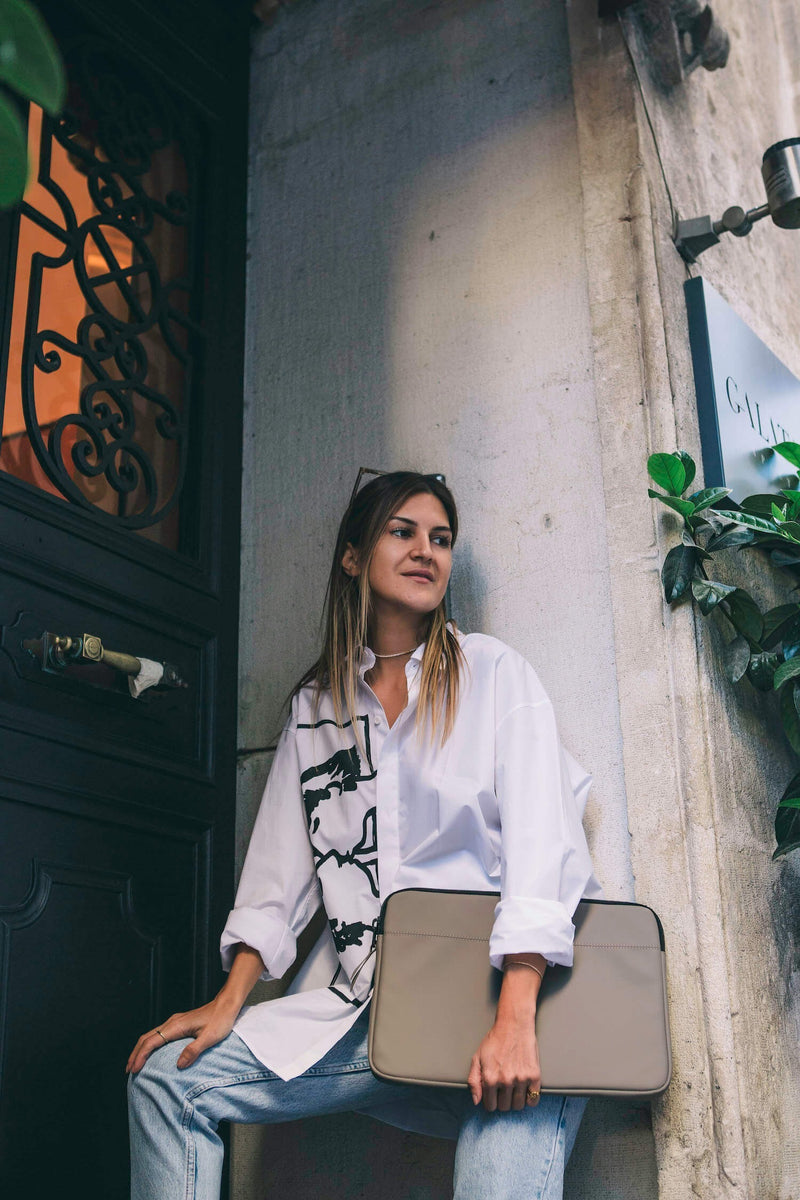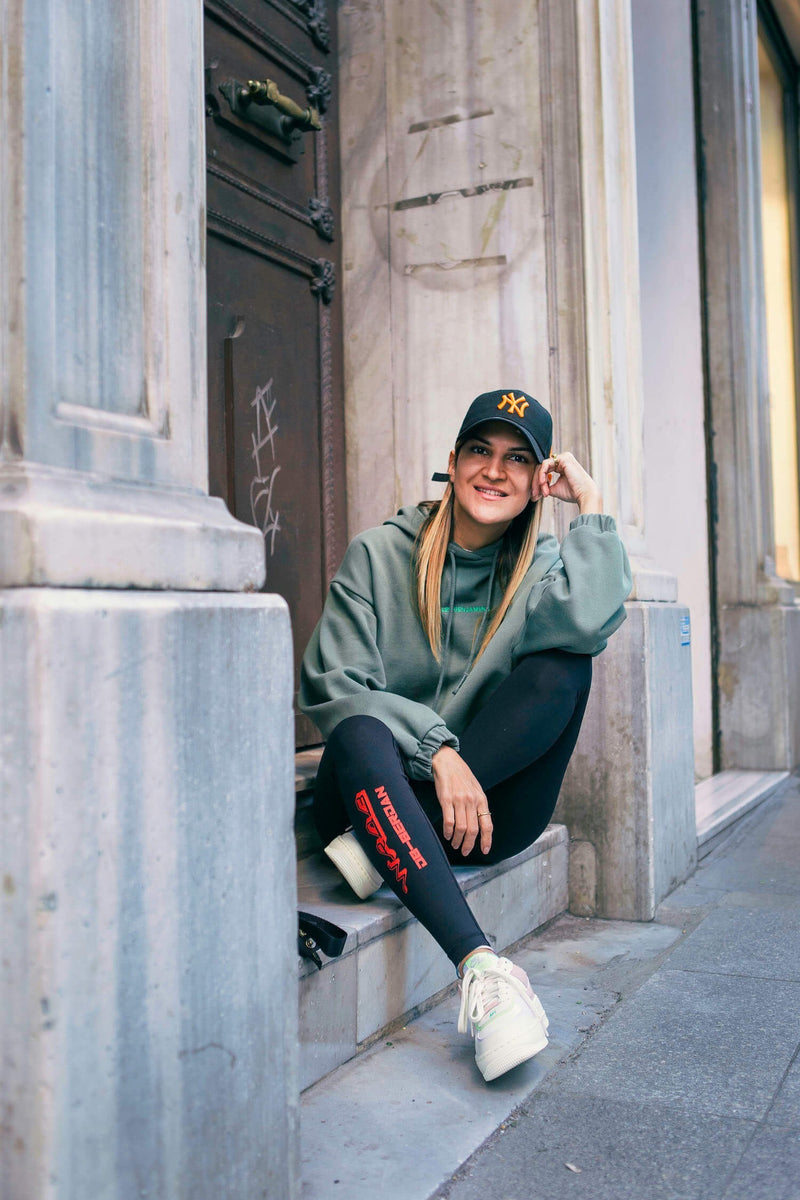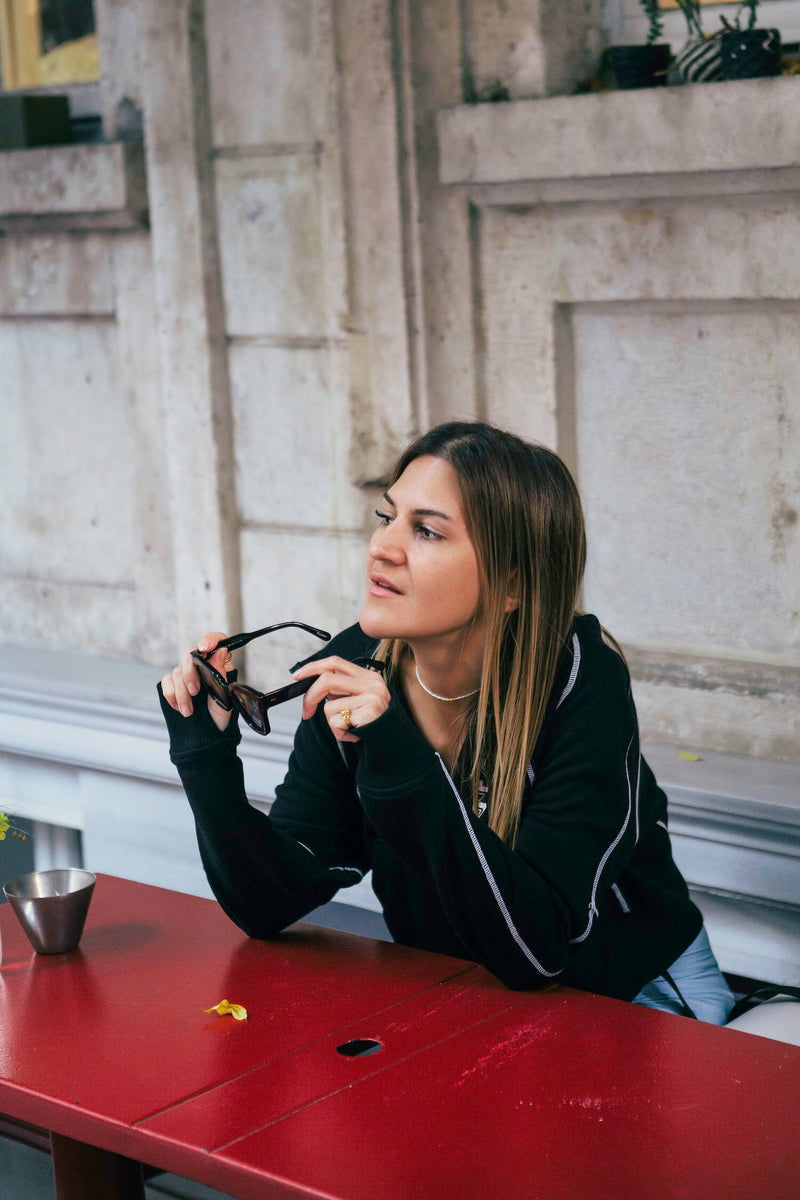Good People of vitruta: İpek Şensılay
Meet İpek Şensılay, the newest member of Good People of Vitruta! Up until now, we’ve spent most of our time with İpek at our favorite spot in Cankurtaran, Giritli, at our Vitruta store located under the Yazıcızade Building in Tophane, and in Urla, where we’ve built a wonderful friendship. This time, we decided to do something different and invited İpek to Comedus in Pera. We had a great chat, toured our store right across from Comedus, and enjoyed the rare winter sunshine as we strolled through the streets of Pera. We hope you enjoy our delightful conversation as much as we did.


Welcome, İpek! Let’s introduce you to the followers of Good People of Vitruta. Who is İpek Şensılay? What does she do, how did she start, and how is her journey progressing?"
Hello! This is actually the hardest question for me. I’ve worked in so many different fields, trying various jobs, and finally found the work I truly enjoy—how to summarize that? When I think about it, I was clearer about what I wanted when I was younger. :) Determined to study fine arts in Italy, I attended the Italian High School and then enrolled in visual arts at Bologna DAMS. But by the time I graduated, I was unsure about what to do next, so I continued with film studies in cinematography. I had even worked as an assistant director in the opera, drawn to that magical world and with a strong interest in stage arts and behind-the-scenes work.
But during university, small translation jobs I did for pocket money led me to MSA (a culinary arts academy), where I suddenly found myself as a tutor for Turkish students at Marchesi's culinary school Alma. Perhaps it was in my blood, since my mother also owned a restaurant. I thought, 'Okay! I’ll develop my career in this field and combine it with what I studied.' So I leaned towards food styling. Then, back in Turkey, I briefly wondered if I should gain some corporate experience, so I joined the Marketing department of a large multinational company. After trying so many different areas and still not finding what made me happy, I stepped away from the corporate world, took a break to listen to myself, and turned my hobby into a job.
I returned to Italy, studied fashion and design in Treviso, and started focusing on jewelry design and goldsmithing. Now, I’m content here. :) I spend my time doing what I love in a field where I can be creative. Making people happy with the pieces I create, especially custom orders, brings a unique satisfaction and happiness. Isn’t that our ultimate purpose in life—to be happy and to spread happiness? It was a long journey, but the destination was beautiful.
Would you like to tell us about Breeze of Greece?
We had a house in Greece and used to go there often. During my break from corporate life, I went there again for some time off. Since childhood, I’ve always collected pebbles, driftwood, and seashells from the beach. That summer, I told my first mentor, Constantinos, that I wanted to make jewelry with these beach treasures. Since he was a jeweler working with precious stones and gold, he initially thought I was a bit crazy when I showed him my ‘junk’ and said, ‘Let’s make jewelry!’ :) But then he warmed up to the idea. At first, I would design, and he would turn my designs into jewelry. Later, I asked him to teach me, and because I enjoyed it so much, I learned quickly. I further developed my skills by watching master artisans at the Grand Bazaar. Since it all started on Greek beaches, I named my brand ‘Breeze of Greece.’ Collecting beach waste and melting down and repurposing old jewelry for new pieces led my brand to evolve into an environmental project. Alongside my Dutch partner, Ellis, we founded ‘Breaking a Bag Habit,’ a project funded by a grant to run workshops with children, raising awareness about pollution. The pandemic slowed it down, but that project is still ongoing. My goal is to produce sustainable, upcycled jewelry, and I love Vitruta for its sustainability program and awareness. :)
What inspires you in your designs?
Honestly, I could say everything. Any object that looks aesthetic to me or has a story to tell can be an inspiration. Right now, I’m working on a collection using pieces from 80-100-year-old rugs from a valuable mentor, one of the master rug dealers of the Grand Bazaar, transforming them into jewelry. This collection also aligns well with my upcycling goals. I created hairpins inspired by the walls of Çeçeyan Han in Karaköy. So, whether it’s a piece of textile, a seashell, the decoration on a building façade that caught my eye, a historic artifact I saw in a museum, or simply colors, patterns, and textures, anything can inspire me. Mythology, fairy tales, and of course, nature—the greatest inspiration for us all—are my sources of inspiration.


Since Greece—and perhaps specifically Crete—is reflected in the name of your brand, it would be fitting to ask about Greece's place in your life, wouldn’t it?
Greece is my second home. For many years, we even had a house in Alexandroupoli. My mother’s father's side of the family is of Cretan descent. I’d say there are very few places in Greece we haven’t seen, yet oddly enough, we’ve never visited Crete. I’m not sure what has kept us away from there—maybe it’s the migration stories we grew up hearing. There’s a kind of nostalgia I feel, like when we raise a glass to the soft sounds of rembetiko playing in the background of my mother’s restaurant, though I can’t exactly say what for. Even though I haven’t experienced it myself, there’s something that feels like a family legacy deep within me. It’s as if, in a parallel world, a life is still going on there. A part of me lives in Crete, while another part says, 'We probably won’t find that home in those stories anymore, and I don’t want to go there as just a tourist.' That strange saying from Reha Muhtar, 'wherever you live and are kept alive,' finally made sense to me after living abroad for so many years. I realized that we can carry homes and homelands within us.
While we’ve touched on your corporate experience and your work as a designer, let’s also talk about your connection to the world of gastronomy. I think it’s fair to say you have a strong bond with and a deep understanding of food.
Food culture has always influenced my life. We always had long dining tables in our home—not in terms of extravagance, but filled with a variety of carefully prepared dishes. Gathering around that table in all kinds of situations was important. For example, I often ask my mom to tell me how, on the day my great-grandfather passed away, they bought a 13-kilogram scorpionfish to cook his favorite meal. She and her cousin dragged this enormous fish up the hill with a trail of cats following them. They celebrated him with his favorite meal and a glass of rakı, saying goodbye in a way that felt like a festival rather than mourning. To me, food is deeply intertwined with life; it’s a culture that shapes life and represents a shared heritage. When I worked at Alma, the culinary school, I had classes on food history and culture, which made me realize that, sociologically, food says so much about who we are. In Italy, I met friends who had preconceived notions about Turks, but after I invited them over for a meal and cooked Turkish dishes, their assumptions would instantly disappear. Food has this incredible power to bring people together—it’s a common language everyone can speak. In our family restaurant, Giritli, anyone who stops by sits down together. People who might not even know each other share an experience that wouldn’t happen under different circumstances, but around a table, they become friends. I sometimes work at Giritli too, not in the restaurant management side, but I love helping with the design aspect of the food, fulfilling special catering requests for our guests, and assisting at exclusive events.
Cankurtaran is a truly unique neighborhood, a place many of us love to visit, though you’ve known it much longer than we have. It’s a part of old Istanbul, where history can still be felt deeply. Over time, your identity as a designer has also connected you to Istanbul’s Grand Bazaar. What does that area of Istanbul, the historical peninsula, mean to you?
Cankurtaran is one of the oldest neighborhoods in Istanbul. Many residents there have lived in the same house for generations. For example, the surname of Oya Hanım, our neighbor across the street from our shop, is the name of that street. Although the community has somewhat dispersed, some Roma musician families still live in the neighborhood. As you walk through the streets, you might hear a melody or see a henna wedding happening between the narrow alleys. If the weather is nice, people sit outside in front of their houses, the elderly of the neighborhood gather in front of the tailor’s shop for a chat over drinks, discussing the state of the country despite their different political views, and the head of the neighborhood (the muhtar) is off making photocopies. It’s not a wealthy neighborhood, but it’s built on some of the richest legacies in the world. Byzantine remnants have been found beneath some of the houses. The walls surrounding our restaurant’s garden are actually historical fortifications. Later, our garden became the palace’s kitchen, and ever since then, that courtyard has always served food. Perhaps that’s why it has this sense of abundance.
The historical peninsula is something else entirely. Yes, other neighborhoods may be in Istanbul, but Istanbul itself, in the truest sense, only exists there.


Let’s say we want to spend a Saturday walking around the Historic Peninsula. What restaurants, cafes, stores, bookstores, or shops would you recommend? What kind of route would you suggest?
Starting with Gülhane Park, we find ourselves stepping into a scene from a period film as soon as we reach Soğukçeşme Street. That street is so inspiring to me—I wish all the houses there had been restored similarly. I also love that it's closed to traffic. I enjoy wandering there and then heading to the Istanbul Archaeology Museums, where I can sit in their marvelous garden and admire what I consider to be some of the world’s most impressive collections. From there, I take a leisurely stroll toward Topkapi Palace, making a stop at Hagia Irene in the first courtyard. As far as I know, this is the first church built in Istanbul by the Byzantine Empire. Its name, meaning ‘Holy Peace,’ has been preserved within the palace, reflecting the Ottoman tradition of tolerance, which I find fascinating. And if you’re lucky enough to catch a concert there, don’t miss it. Listening to classical music in that setting is an entirely different experience.
After that, I’d head toward Çemberlitaş and, following Peykhane Street, stop by the Şerefiye Cistern. It amazes me how spectacular this cistern is, yet not as widely known as the Basilica or Binbirdirek Cisterns. On my way to Giritli, I would take a slight detour to the Four Seasons Hotel, which has a fascinating history as a former prison. On the right, I’d visit The Columns Mehmet Çetinkaya Gallery, which houses Byzantine columns over 1,800 years old. It truly feels like a treasure trove! I might also visit the Museum of the Palace Mosaics, across from the Four Seasons, and then pause at what I think is the best viewpoint of the Blue Mosque before heading down toward the shore.
Another route I enjoy takes me down the street between Hagia Sophia on my left and the Blue Mosque on my right. I pass by the Istanbul Arts Bazaar in the first alley on the left, where I can find some wonderful art books. I especially love sitting in the courtyard in autumn, flipping through a book with a cup of herbal tea amid the colorful fallen leaves. You can meet artisans working in various crafts in the small studios around the courtyard and buy their handmade items. And maybe, later, you’ll take a moment to admire the centuries-old plane tree in the courtyard of the Blue Mosque, imagining everything it has witnessed over the years. There’s also a ruined, unidentified ancient cistern across from the Serpent Column at At Meydanı, with no inscription explaining it. I’ve heard it connects underground to both İbrahim Paşa Palace and the Basilica Cistern. What intrigues me most is the unseen, buried Istanbul beneath us. An enormous wealth lies right under our feet, remnants of countless civilizations we unknowingly walk over every day.
Istanbul is truly unique, one of a kind. I’d love to increase my knowledge and organize a comprehensive tour of the Peninsula and the Grand Bazaar.
Maybe one day we’ll explore it all together. :)
What have you been watching, reading, and listening to lately?
It feels like there’s always a fine line between utopia and dystopia. I recently watched a film that starts out seeming utopian but quickly becomes a dystopian thought experiment, and its storyline really impacted me. The film, *El Hoyo* (The Platform), sharply confronts us with issues of class disparity, social advantages/disadvantages, and the moral tightrope between human desires and doing the right thing. Another dystopian film that left a strong impression on me was *The Social Dilemma*. It made me wonder how we can shape modern life to use technology in a way that benefits humanity.
After those two, let me give you a couple of lighter recommendations! *Faces Places*, a heartfelt documentary by filmmaker Agnès Varda and photographer/street artist JR, explores the French countryside in such a charming way. And for animation, *Soul* is a beautiful, motivating film that encourages us to live our limited time fully, doing work we love and are passionate about.
For TV series, I recently started *Succession*, and it quickly hooked me. We've also been talking a lot about *Kulüp* lately, and if you haven't seen it yet, I definitely recommend it. It’s a bit older, but I also just discovered *Lilyhammer*, which I got really into after a few episodes!
I’d recommend all the books by Berrak Yurdakul, and it's a treat to listen to her works on Storytel in her own compelling voice. For more book suggestions, follow Eylül Görmüş—she’s introduced me to amazing reads. On YouTube, I follow Eylül on *Kafa TV*, as well as Zafer Algöz.
As for podcasts… I listen to them constantly while working. Some favorites are *Nasıl Olunur* by Nilay Örnek, *ben okurum* by Deniz Yüce Başarır, and podcasts by Evrim Kuran. *Podfresh Sokaktan Kulağa* introduces you to inspiring people doing great work. I also enjoy listening to stories on Judith Liberman’s podcast—I still love a good fairy tale! For Italian speakers, I recommend Feltrinelli’s podcast series, where they honor great masters. I often revisit the podcasts of Doğan Cüceloğlu and Ferhan Şensoy.
Lately, I’ve been into instrumental, minimalist electronic music. There’s a great *abstract hip-hop & lo-fi* playlist on Spotify that’s perfect as background music while working.